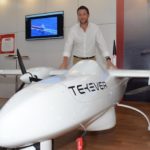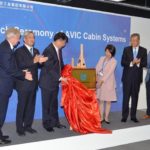Personal air mobility vehicle would use existing heliport and airport infrastructure
Rolls-Royce has unveiled a concept electric vertical take-off and landing (EVTOL) vehicle at the Farnborough International Airshow 2018.
The design could be adapted for personal transport, public transport, logistics and military applications. The vehicle could take to the skies as soon as the early 2020s.
The Rolls-Royce EVTOL project is part of the company’s strategy to ‘champion electrification’ and become a world leader in industrial technology company. The project builds upon experience gained providing hybrid electric propulsion for trains, naval vessels and other applications and expertise in gas turbines, VTOL technology, systems analytics and aerospace regulation and certification.
Rolls-Royce would expect the commercial introduction of EVTOL to involve working in collaboration with airframers and will seek a range of strategic partners for aspects of the electrical system. The company believes the model could be available by the early to mid 2020s, provided a viable commercial model for its introduction can be created.
Battery charged by gas turbine
The initial concept vehicle uses gas turbine technology to generate electricity to power six electric propulsors specially designed to have a low noise profile. It also has a battery for energy storage. The hybrid-EVTOL configuration could carry four or five passengers at speeds up to 250mph for approximately 500 miles and would not require re-charging as the battery is charged by the gas turbine. The vehicle would utilise existing infrastructure such as heliports and airports.
Electrification is an exciting and inescapable trend across industrial technology markets
Rob Watson, who heads up Rolls-Royce’s Electrical team, said: “Electrification is an exciting and inescapable trend across industrial technology markets and while the move to more electric propulsion will be gradual for us, it will ultimately be a revolution. Building on our existing expertise in electric technologies and aviation, Rolls-Royce is actively exploring a range of possible markets and applications for electric and hybrid electric flight. We are well placed to play a leading role in the emerging world of personal air mobility and will also look to work in collaboration with a range of partners.”
He added: “Rolls-Royce has a strong track record as pioneers in aviation. From developing the first turbo-prop and jet engines, to creating the world’s most efficient large civil aero-engine and vertical take-off and landing solutions, we have a very strong pedigree. As the third generation of aviation begins to dawn, it’s time to be pioneers yet again.”
Rotating wings enable vertical landing and take off
The initial Rolls-Royce EVTOL concept uses an M250 gas turbine embedded within the rear of the aircraft and modified as part of a hybrid electric propulsion system. The wings are able to rotate 90 degrees, enabling the vehicle to take off or land vertically. Propellers on the wing could fold away once the craft has reached cruising height, reducing drag and cabin noise, with the craft relying upon the two rear propellers for thrust.
The EVTOL – or personal air mobility – market is emerging as a result of technological advances and a need to meet the demands that will be placed upon conventional transport systems as more of the world’s population lives in congested cities.

